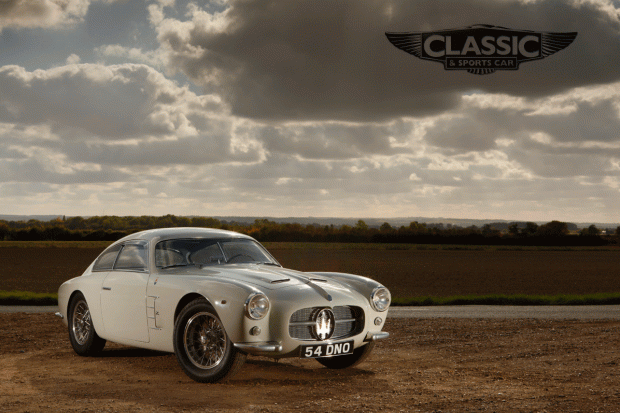
Private underground city car parks conceal some secret motors, but few are as surprising as this early-1950s Maserati coupé. As we drop down to the basement storage, the lift doors opened to reveal a subtle grey Zagato-bodied beauty conspicuously placed among bland moderns. Even under the sterile neon glow of its stark hideaway, this sleek, compact exotic looks like a pert supermodel among dinnerladies. Amazingly, there are no barriers to protect its delicate, hand-formed aluminium body, and you can’t help feeling that this rare 1954 GT should be displayed across the river in the Tate.
Ugo Zagato’s team of artisans at the Via Arese works in Milan had a great eye for natural form and pretty much defined the classic coupé look in the early 1950s. None of the 20 Zagatos were identical because details and trim continually evolved and just one chassis, 2121, had the signature ‘double-bubble’ roof. “Great designs don’t come from wanting to produce a good shape,” Zagato claimed, “they come from making cars faster and more intelligent.” The house of Zagato may have lost that defining ‘Grinta e Sportività’ purity in its later years, but the only route for the Italian gentleman racer in the early ’50s was via the famous Milanese carrozzeria. Rivals Allemano and Frua both bodied the updated 2-litre coupé between 1954 and ’57, but none of the 60 built matched Zagato’s seductive fastback.

The owner of this twin-cam, straight-six jewel – the only 2000GT in the UK – has generously entrusted me to deliver the car solo from London to respected Norfolk-based Maserati specialist Steve Hart for its annual service. And there are few more dramatic places to start up the Vittorio Bellentani-revised 160bhp motor than a silent underground car park. Twist the key, push the button and this thoroughbred heart – with chain-driven cams and triple Webers – barks instantly into life. The throaty exhaust boldly fills its concrete-walled lair. Close your eyes and it could be a 250F revving up in a Monza pit garage. Once the engine is warm, I point the car’s shapely snout towards the ramp, and can’t resist stretching the revs in first gear as it heads up to the barrier. The strident howl sounds even richer around the narrow tunnel. Out into the Sunday night city traffic, the Maserati soon gets approving interest, none more so than from a Ducati rider who follows me for miles. He pulls alongside at every set of lights and soaks up its alluring shape and boisterous tone. Well I’d do the same, because the chances of seeing another like this on British roads are minimal. Even in the ’50s these Maserati gran turismos were mainly sold in Italy, where wealthy owners battled with rival Lancia Aurelias, Fiat 8Vs and Alfa 1900SS Zagatos for the popular GT championship.

Out on to a deserted dual carriageway, the 2000GT – better known as the A6G/54 – starts to come alive. The gearbox, via the tall alloy-ball-topped lever, is a treat to work with its rewarding mechanical feel as you slice through the gate, while the steering’s initial deadness transforms into a silky, precise action at speed. You sense that the handling is beautifully neutral on clear roundabouts, as the ‘six’ delivers strong, smooth punch. You need no excuse to hold the revs right to 5000rpm through the gears for the buzz from that addictive yowl as the chassis holds its line neatly. It’s not crying wolf, either: this ’54 GT is as quick as it sounds thanks to a healthy power-to-weight ratio and will give most hot hatches a challenge up to 80mph. The flat leather seats offer little support, while the low roofline creates a widescreen view of the road that all adds to the period character. My only concern is the lack of outside mirrors as the suspension crashes painfully over London’s cursed potholes.

It’s easily the most valuable car ever stashed at my home, so I’m up long before the rush hour and the protracted warm-up predictably upsets the neighbours. I choose the North Circular rather than the M25 slog, and again the pre-dawn darkness fuels Mille Miglia fantasies.





